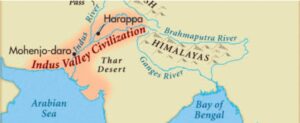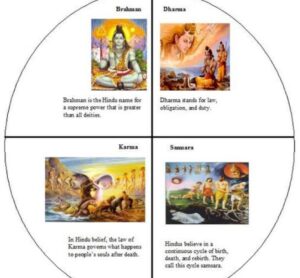Exploring Hinduism 3300-1300BCE Origin, Beliefs and Diversity
Hinduism is the major world religion originating on the Indian Sub-continent and comprising several and varied systems of belief, philosophy, culture and ritual. The name Hinduism is relatively new and having been coined by British writers in the first decades of the 19th century, it refers to a rich cumulative tradition of texts and practices, some of which date to the 2nd millennium BCE or possibly earlier.
The origins of Hinduism :
are deeply rooted in ancient history, and its evolution is a gradual process that occurred over thousands of years. There isn’t a single founder or a specific event that marks the beginning of Hinduism. Instead, it developed organically through the synthesis of various cultural, religious, and philosophical influences in the Indian subcontinent. Here are some key points about how Hinduism evolved:
1. Indus Valley Civilization (circa 3300–1300 BCE):
– Some archaeological findings suggest practices and symbols that might be linked to early forms of Hinduism in the ancient Indus Valley cities like Mohenjo-Daro and Harappa.
2. Vedic Period (circa 1500–500 BCE):
– The religious texts known as the Vedas were composed during this period. These texts contain hymns, rituals, and philosophical ideas and laid the foundation for early Hindu religious thought.
3.Upanishadic Period (circa 800–200 BCE):
– The Upanishads, philosophical texts exploring the nature of reality and the self, were composed. These texts introduced concepts like Brahman (the ultimate reality) and Atman (the individual soul) and laid the groundwork for key Hindu philosophical ideas.
4. Epic Period (circa 500 BCE–500 CE):
– The two major Hindu epics, the Mahabharata and the Ramayana, were composed. These epics not only contain stories of heroes and gods but also incorporate moral and philosophical teachings.
5. Golden Age and Classical Period (circa 500–1500 CE):
– During this period, major Hindu texts, such as the Bhagavad Gita, were written. Hinduism diversified into various sects and schools of thought, leading to the development of different philosophical and religious traditions.
6. Medieval and Modern Period:
– Hinduism continued to evolve through the medieval period with the rise of bhakti (devotional) movements and the influence of various rulers and dynasties. In the modern era, Hinduism adapted to social, political, and cultural changes.
7. Colonial Influence:
– British colonial rule in India influenced the study and interpretation of Hinduism, leading to a deeper understanding of its ancient texts and traditions.
Hinduism’s development was shaped by interactions with various cultures, religions, and philosophical ideas in the Indian subcontinent. It is a complex and diverse belief system that continues to evolve even in the contemporary era.
Basic Beliefs in Hinduism:
– Brahman: The ultimate, unchanging reality, often described as the supreme, eternal, and infinite divine power that sustains the universe.
– Atman: The individual soul, eternal and divine, believed to be a part of Brahman.
– Reincarnation and Karma: The cycle of birth, death, and rebirth (samsara). One’s actions (karma) in past lives influence future lives.
– Dharma: Moral and ethical duties that vary based on one’s age, caste, gender, and occupation.
Deities in Hinduism:
– Hinduism is polytheistic, with millions of gods and goddesses. Some popular deities include Brahma (the creator), Vishnu (the preserver), Shiva (the destroyer), Lakshmi (goddess of wealth), Saraswati (goddess of knowledge), and Durga (goddess of power).
Scriptures in Hinduism:
– Vedas: Ancient sacred texts containing hymns, rituals, and philosophical teachings.
– Upanishads: Philosophical texts exploring the nature of reality, self, and the ultimate truth (Brahman).
– Bhagavad Gita:A 700-verse Hindu scripture within the Indian epic Mahabharata, presenting a synthesis of Hindu ideas about dharma, theistic bhakti, and the yogic paths to moksha.
Practices and Rituals in Hinduism:
– Puja: Ritual worship of deities performed in homes or temples.
– Meditation and Yoga: Practices aimed at spiritual and mental well-being.
– Festivals: Diwali (Festival of Lights), Holi (Festival of Colors), Navaratri (Nine Nights Festival) are some of the major Hindu festivals celebrated with enthusiasm.
Divisions within Hinduism
Hinduism is a diverse and complex religion with a wide range of beliefs, practices, and traditions. While it does not have a central religious authority or a single universally followed set of beliefs, it can be broadly categorized into various sects, schools of thought, and regional practices. Here are some of the major divisions within Hinduism:
Vaishnavism, Shaivism, and Shaktism:
– Vaishnavism: Devotees primarily worship Vishnu and his incarnations like Rama and Krishna.
– Shaivism: Devotees primarily worship Shiva, the god of destruction and regeneration.
– Shaktism: Devotees primarily worship the divine feminine energy, often represented as Goddess Durga, Kali, or Lakshmi.
Bhakti and Karma Traditions:
– Bhakti Tradition: Emphasizes devotion and worship of a personal god, often through hymns, prayers, and rituals.
– Karma Tradition: Focuses on the law of karma, emphasizing righteous actions and their consequences in this life or the next.
Advaita Vedanta and Dvaita Vedanta:
– Advaita Vedanta: Non-dualistic philosophy that asserts the oneness of the individual soul (Atman) with the ultimate reality (Brahman).
– Dvaita Vedanta: Dualistic philosophy that emphasizes the distinction between the individual soul and the divine.
Smartism:
– A tradition that recognizes multiple deities, including Vishnu, Shiva, Shakti, Ganesh, and Surya, as different manifestations of the same divine reality.
Regional and Folk Traditions:
– Hinduism exhibits a wide array of regional practices, beliefs, and rituals, often influenced by local cultures and traditions. Folk and tribal traditions are an integral part of Hinduism’s diversity.
Caste System in Hinduism:
– While not a religious division, the caste system historically influenced social divisions in Hindu society, although its influence has diminished in modern times.
The caste system is a social hierarchy in India that divides people into different groups based on their social status, ancestry, and occupation. It has been a prominent feature of traditional Hindu society. Here are the key components of the caste system:
Caste Categories:
– Brahmins: Priests and scholars, traditionally responsible for religious rituals and teaching.
– Kshatriyas: Warriors and rulers, historically responsible for protecting the society and maintaining law and order.
– Vaishyas: Merchants and farmers, involved in trade, agriculture, and commerce.
– Shudras: Laborers and service providers, performing tasks considered menial or impure.
– Dalits (or Scheduled Castes): Historically marginalized groups engaged in occupations deemed ritually impure, such as sanitation work. They were often excluded from mainstream society.
The caste system’s origins are complex and multifaceted, with roots in ancient texts like the Manusmriti. Over centuries, it became deeply entrenched in Indian society.
Endogamy and Social Hierarchy:
– Caste groups traditionally practiced endogamy, marrying within their own caste. Inter-caste marriages were discouraged.
– The system enforced a rigid social hierarchy, determining a person’s social, economic, and educational opportunities based on their caste at birth.
Challenges and Changes:
– Modern Challenges:The caste system has been widely criticized for perpetuating social inequality, discrimination, and injustice. Discrimination against Dalits still exists in various forms.
– Reservation Policies:The Indian government has implemented affirmative action policies to uplift marginalized castes, providing reserved seats in education, government jobs, and politics.
Social Reform Movements:
– Various social reformers like Raja Ram Mohan Roy, B.R. Ambedkar, and Mahatma Gandhi worked to challenge and mitigate the effects of the caste system. Ambedkar, in particular, played a key role in drafting the Indian Constitution, which outlawed untouchability.
Contemporary Dynamics:
– While the caste system’s influence persists in some areas, urbanization, education, and economic development have led to increased social mobility and breaking down of caste barriers, especially in urban centers.
It’s important to note that the caste system is a deeply ingrained social structure that continues to be a complex issue in contemporary India, influencing social relationships and politics. Efforts to address its negative aspects are ongoing, aiming for a more egalitarian society.
These divisions represent a fraction of the diversity within Hinduism. Each division may have further sub-divisions and interpretations, making Hinduism one of the most complex and multifaceted religions in the world.
Philosophical Schools:
– Hinduism encompasses diverse philosophical schools, including Advaita Vedanta (non-dualism), Dvaita Vedanta (dualism), and Yoga philosophy, each offering different perspectives on the nature of reality and the path to spiritual liberation.
Impact and Spread of Hinduism:
– While predominantly practiced in India and Nepal, Hindu communities can be found worldwide, especially due to migration and the Indian diaspora.
– Hindu ideas, art, and culture have significantly influenced the Indian subcontinent and Southeast Asia.
While Hinduism originated in the Indian subcontinent, it has spread globally due to migration, the Indian diaspora, and globalization. Today, Hindu communities can be found in various parts of the world, particularly in countries with significant Indian immigrant populations. Countries such as the United States, Canada, the United Kingdom, Australia, and several nations in Southeast Asia and Africa have Hindu communities and temples, contributing to the global presence of Hinduism.
Jyotirlingas – Legends and Significance of the 12 Sacred Abodes of Lord Shiva




1 thought on “Exploring Hinduism 3300-1300BCE Origin, Beliefs and Diversity”